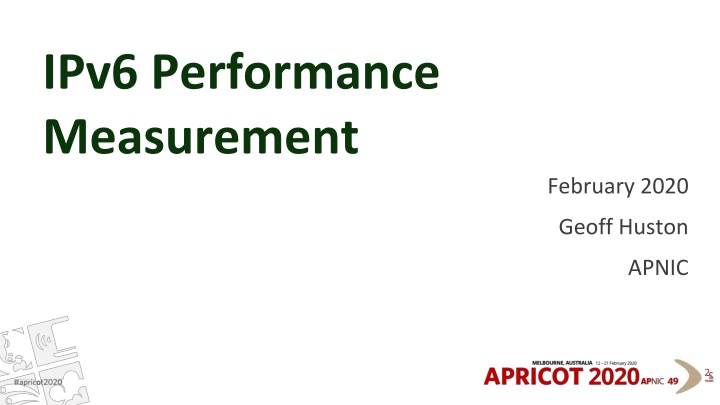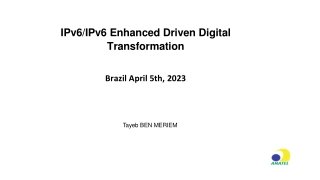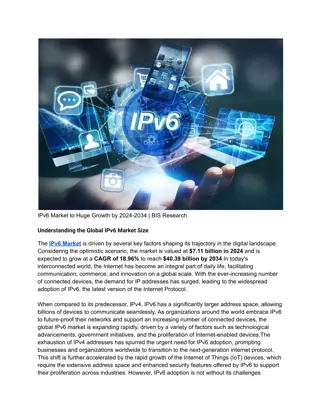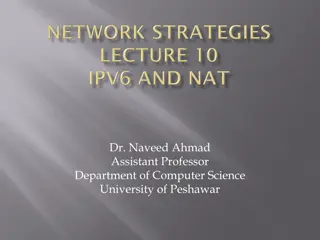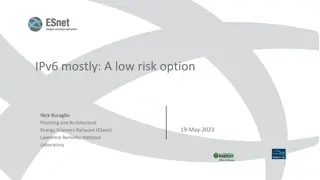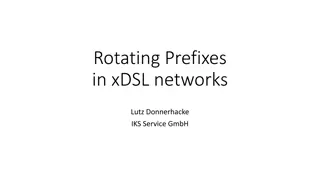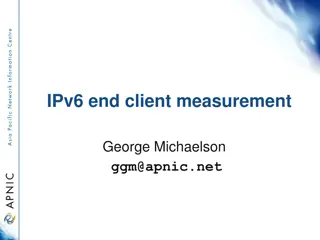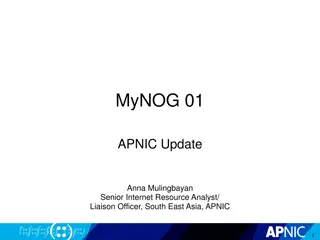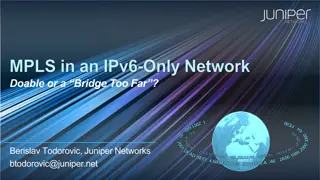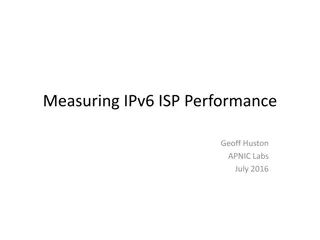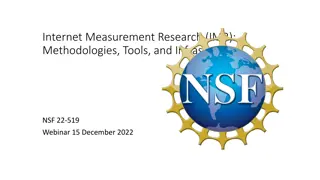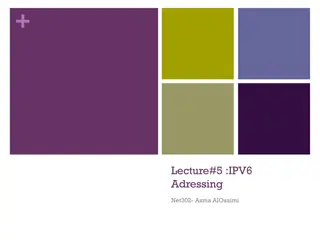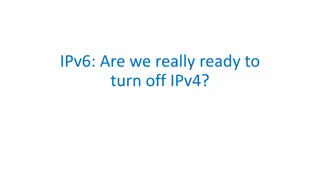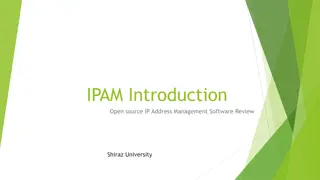IPv6 Performance Measurement
This study by Geoff Huston at APNIC delves into the performance measurement of IPv6 networks during February 2020. It covers aspects such as TCP connection failures, SYN handshake reliability analysis, and the global failure rate observed in IPv6 connections. The research explores reasons behind deteriorating performance, including routing instability and possible causes of packet delivery failures within IPv6 networks.
Download Presentation

Please find below an Image/Link to download the presentation.
The content on the website is provided AS IS for your information and personal use only. It may not be sold, licensed, or shared on other websites without obtaining consent from the author.If you encounter any issues during the download, it is possible that the publisher has removed the file from their server.
You are allowed to download the files provided on this website for personal or commercial use, subject to the condition that they are used lawfully. All files are the property of their respective owners.
The content on the website is provided AS IS for your information and personal use only. It may not be sold, licensed, or shared on other websites without obtaining consent from the author.
E N D
Presentation Transcript
IPv6 Performance Measurement February 2020 Geoff Huston APNIC
The Measurement The endpoint that runs the experiment attempts to retrieve two URLs from the same remote server one using IPv4 and the other using IPv6 Unique DNS names and HTTPS are used to ensure that caching does not play a role in the measurement each retrieval is from our content server IPv6 Connection Ad Placement Users Browser Content Server IPv4 Connection
Measurement Volume Ad Impressions per day for the period 2017 - 2020
The Measurement We perform full packet capture at the server Data analysis We look at the SYN/ACK exchange at the start of the TCP session A received SYN with no subsequent ACK is interpreted as a failed connection attempt Syn/Ack Syn/Ack 1 RTT Ack Server Client
Analysis - Reliability Why measure SYN handshake failure? In a dual stack environment many of the most widely used apps (browsers) use Happy Eyeballs to decide which protocol to select Happy Eyeballs bases its decision on the first protocol to complete a TCP SYN handshake So TCP handshake failure will strongly influence this decision
IPv6 TCP Connection Failure The global failure rate of some 2-3% is getting worse! As the IPv6 network is growing, its performance in terms of reliability is getting worse What we are seeing is most likely a failure to deliver an IPv6 packet from the server to the endpoint Possible reasons: Endpoint using an unreachable IPv6 address End site firewalls ??
IPv6 TCP Connection Failure There have been some recent high noise periods This is due to IPv6 routing instability in the North American network parts of the IPv6 routing table appear to have been dropped for some destinations
IPv6 TCP Connection Failure There have been some recent high noise periods This is due to IPv6 routing instability in the North American network parts of the IPv6 routing table appear to have been dropped for some destinations IPv6 instability over 24 hours
The Good This 464XLAT mobile network (T-Mobile) has remarkably small failure rates the endpoints are connected via native IPv6 and as this is a mobile network there is only a small amount of customer- operated filtering middleware The ISP network Server Platform problems
The Good Similar story in India with Reliance JIO the endpoints are connected via native IPv6 and as this is a mobile network there is only a small amount of customer-operated filtering middleware
464XLAT Performance These networks operate in a native IPv6 mode IPv6 connections to a server require no network processing and no client handling
Comment For many end-users their IPv6 service looks pretty broken The combination of Dual Stack and Happy Eyeballs masks the problem so that the user does not experience a degraded service But this only will work while Dual Stack is around Other ISPs have managed to do a much better job, such as in the India, Iceland, Australia and Korea and the IPv6 connection failure rates are close to experimental noise levels What s happening in the second set of countries and ISPs
Transition Technologies Stateful transition technologies that involve protocol translation show higher levels of instability Translation technologies that require orchestration of DNS and network state are also more unstable
Dual Stack is NOT the Goal Despite all the grim predictions that IPv4 will be around for a long time to come, the aim of this transition is NOT to make Dual Stack work optimally The goal is to automatically transition the network to operate over IPv6 The way to achieve this is for client systems to prefer to use IPv6 whenever it can
Happy Eyeballs An unconditional preference for IPv6 can lead to some very poor user experience instances Linux uses a 108 second connection timer, for example Applications (particularly browsers) have used a Happy Eyeballs approach DNS Resolution TCP Handshake A TCP session will be started in IPv6 if there is a IPv6 address record. If the handshake is not completed within 250 ms then an IPv4 TCP session is also fired off DNS A and AAAA are fired off at the same time if the A response comes back first then the application will start a 50ms timer to wait for a AAAA response 50ms AAAA Delay 250ms IPv6 Delay
Tuning IPv6 for Happy Eyeballs When connecting to a remote dual stack service, the Routing Path selection for IPv6 should be similar to IPv4 Where there are path deviations, the path discrepancy should be contained This is not always the case
Sometimes its the DNS! Happy Eyeballs assumes that the time to resolve an A and a AAAA record are within 50 msecs of each other The client generates a query for the A record and a second query for a AAAA record at the same time The recursive resolver does not necessarily process the two requests in parallel: A QNAME minimisation resolver may use A queries to walk the DNS hierarchy A DNS-based content filter may use A queries to determine the outcome
3 Suggestions to Assist IPv6 Robustness Avoid stateful IPv6 -> IPv4 transition mechanisms if possible if you can operate IPv6 in native mode all the better! Avoid using IPv6-in-IPv4 encapsulations Not only are tunnels unstable, but the reduced IPv6 MTU may cause problems with extension header based packet discard Keep IPv4 and IPv6 paths congruent if possible Yes, this can be really challenging for multi-homed
Speed Measurement We perform full packet capture at the server Data analysis We look at the SYN/ACK exchange at the start of the TCP session The time between receipt of the SYN and the subsequent ACK at the server is no less than one RTT between the server and the endpoint (and is a reasonable first order substitute for an RTT) Client Syn/Ack Syn/Ack 1 RTT Ack Server
Analysis - Speed Why measure only the handshake delay? Why not measure a larger data transfer? Because in the end host and the server the same TCP version is used on top of IPv4 and IPv6 If the end to end paths are the same in IPv4 and IPv6 we would see precisely the same session throughput RTT and packet loss probability determine session throughput In this experiment we use the RTT as in indicator of path
Worldwide RTT Diff Performance IPv4 is consistently faster than IPv6 on average
This is a localised measurement This is the result of millions of endpoints heading to one of 4 measurement points If IPv4 and IPv6 paths are aligned then the RTT diff would be close to zero Any deviation points to some form of asymmetric routing issues And whether IPv6 is faster or slower than IPv4 is less important than the fact that they are different But the observation that they are different with respect to a
But thats not all IPv6 used a new approach to extension headers, including packet fragmentation by inserting them between the IPv6 header and the transport header IPv6 header Which means that hardware will have to spend cycles to hunt for a transport header Fragmentation xtn header TCP/UDP xtn header Payload Or it can just drop the packet
2017 Measurement This measurement test involved sending a fragmented UDP packet to recursive resolvers
2017 Measurement This measurement test involved sending a fragmented TCP packet to browser endpoints
What can we say? There are ongoing issues with IPv6 reliability in many parts of the world This appears to relate to local security policies at the client edge of the network We can expect most of this to improve over time by itself
What can we say? But there are also very serious issues with Path MTU management and handling of IPv6 extension headers This is a more challenging issue that will probably not just clean itself up over time Should we just avoid IPv6 extension headers? Or try to clean up the IPv6 switching infrastructure?
What can we say? But there are also very serious issues with Path MTU management and handling of IPv6 extension headers This is a more challenging issue that will probably not just clean itself up over time Unlikely! Should we just avoid IPv6 extension headers? Or try to clean up the IPv6 switching infrastructure?
